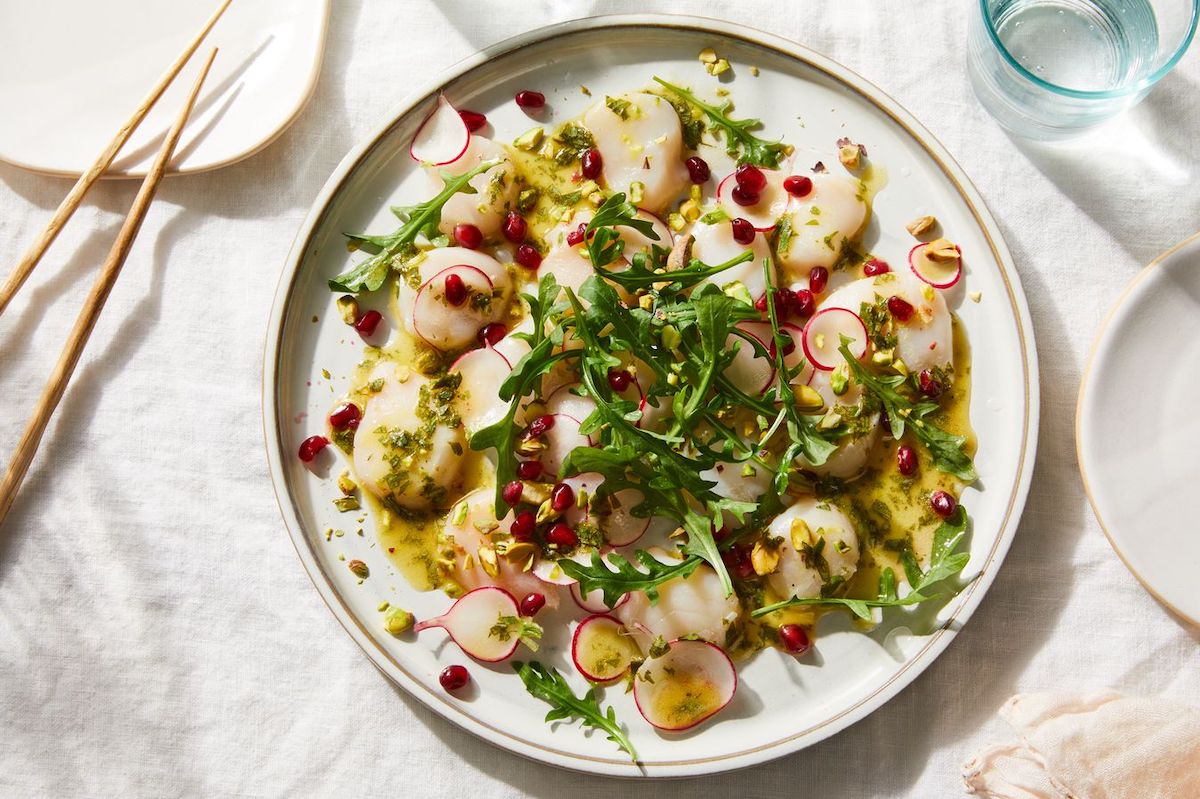The day I joined Alex Todd on his scalloping boat out of Portland, Maine, I missed a key memo: Bring lunch. Alex is a day-boat scallop fisherman, which means he drags for scallops only in the short winter season, leaving at dawn and staying at sea until he’s filled his 15-gallon quota, which that day took 12 hours. Alex’s generosity saved me. While he and his crew ate prepacked sandwiches, I lunched on his scallops, untouched, shucked from their shells minutes before. The answer to can you eat raw scallops is emphatically, 100% yes.
Raw scallops are not just edible; they’re incredible. The scallop’s natural sweetness is never on display so clearly as before it’s cooked. And uses for raw scallops are endless: carpaccio, crudo, tartare, sushi, or, as on that day, just popped in your mouth like candy. The one catch: To go raw, you need to choose your scallops carefully. What you find behind most supermarket seafood counters won’t live up to my lunch at sea.
If you’re planning to eat raw scallops, there are a couple terms you should keep in mind while shopping: “dry” and “day boat.” To understand these qualifiers, it helps to know how your conventional supermarket scallop is harvested and handled. Most sea scallops on the market are caught by large boats that go on harvesting trips lasting up to two weeks. Whether the scallops are caught on day one or day 14, they all go into a hold (a cavernous space in the hull of the boat) and sit on ice for the remainder of the trip. As you can imagine, there is a big quality drop-off for a scallop that’s 14 days old before it even hits the shore, not to mention the time it takes to make it through the supply chain to your supermarket, and then onto your plate. But it’s not just the age that matters; as that ice melts, the scallops begin to soak up excess water. This makes them bigger, but it dilutes their flavor.
When the scallops reach land, the real trickery comes into play. Many scallop processors who buy scallops then give them another soak, this time in sodium tripolyphosphate (a preservative that also makes the scallops suck up a lot more water). Scallops are sold by the pound, so the buyer ends up paying for all that extra water. This process is completely legal, and no labeling is required at the supermarket counter to tell you how old the scallops are, or what they’ve been soaked in. You won’t know until you get home and find that you’re biting into the kind of briny water balloon that definitely shouldn’t be eaten raw — a thoroughly unpleasant experience.
So how do you make sure your scallops are neither weeks old nor full of water and chemicals? First off, make sure you’re buying from a fishmonger or company you trust. This can be a market down the street or an online retailer across the country—the important thing is that they speak knowledgeably about what they’re selling, and can verify where it came from and how it was handled.
Then, demand “day-boat” scallops. Unlike trip boats, day boats bring their catch to shore the same day they are pulled from the ocean. This is less efficient than a two-week-long trip filling a massive hold, but it means the scallops get to you when they’re still incredibly fresh. Those scallops on Alex Todd’s boat? Any that I managed not to devour were landed that night and available for sale the next day, which means you’d get pretty much the same flavor I got on deck.
“Dry” isn’t how the scallops taste; it means that the scallops were never soaked, so what you’re eating is the scallop muscle exactly as it left the shell. Buying dry scallops eliminates the possibility of chemicals and scallops that are too waterlogged to effectively take on the flavors of extra-virgin olive oil, fresh citrus juice, or anything else you’re using to season them. If you’ve never tasted a scallop that hasn’t taken on extra water, you will be shocked by the incredible sweetness and firmness compared to its soaked counterparts.
Buying dry day-boat scallops will certainly cost you more per pound than a chemical-soaked scallop from a trip boat. But the taste, quality, and sustainability you’re buying are well worth the investment, especially when you’re planning to eat them raw. Cooking can mask a lot of flaws, but biting into a raw scallop will tell you much more about that scallop’s journey. Keep that journey from the ocean to your plate short, simple, and trustworthy, and you’ll be wondering why you’ve been wasting all that time over the stove.
Related recipes


